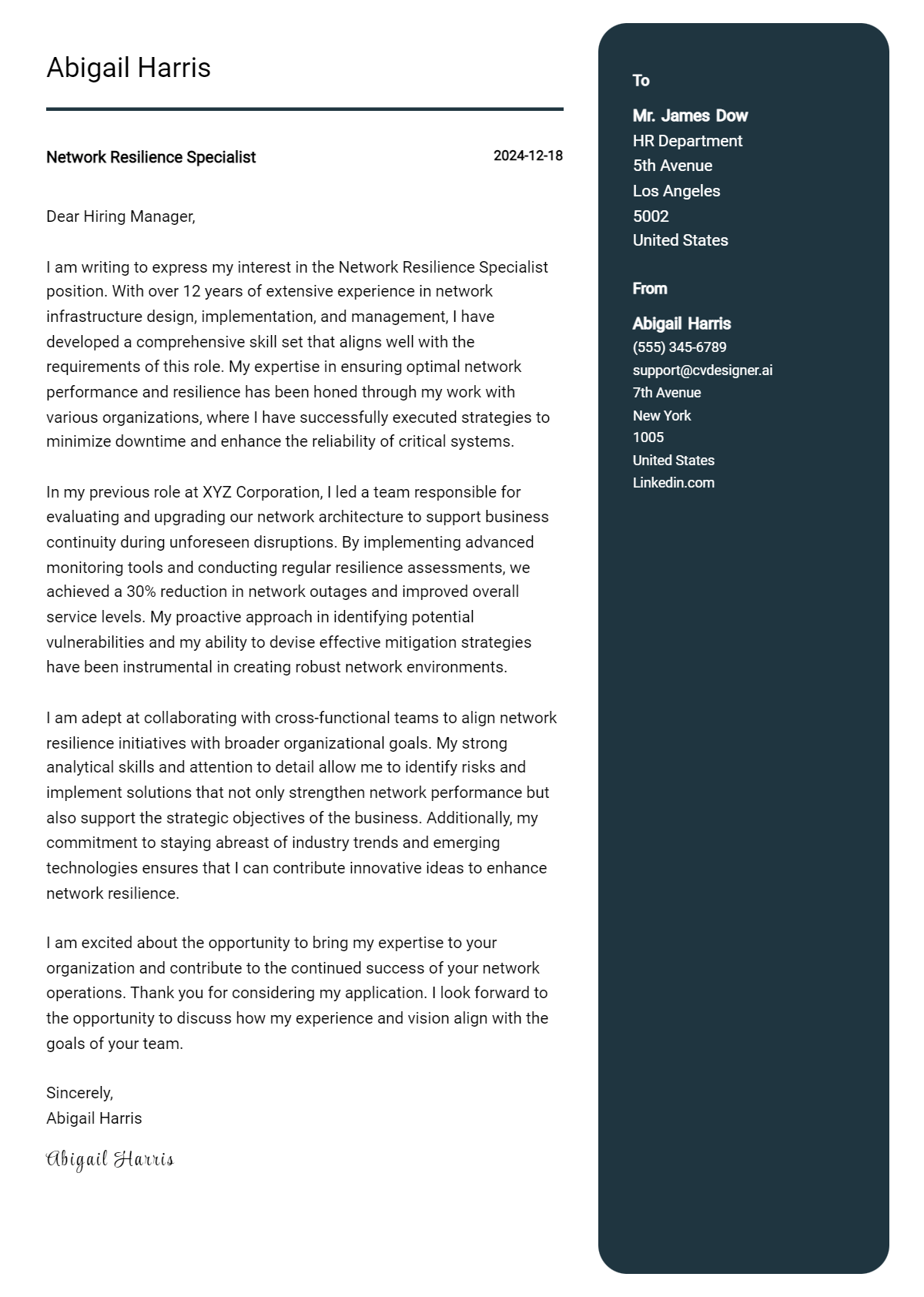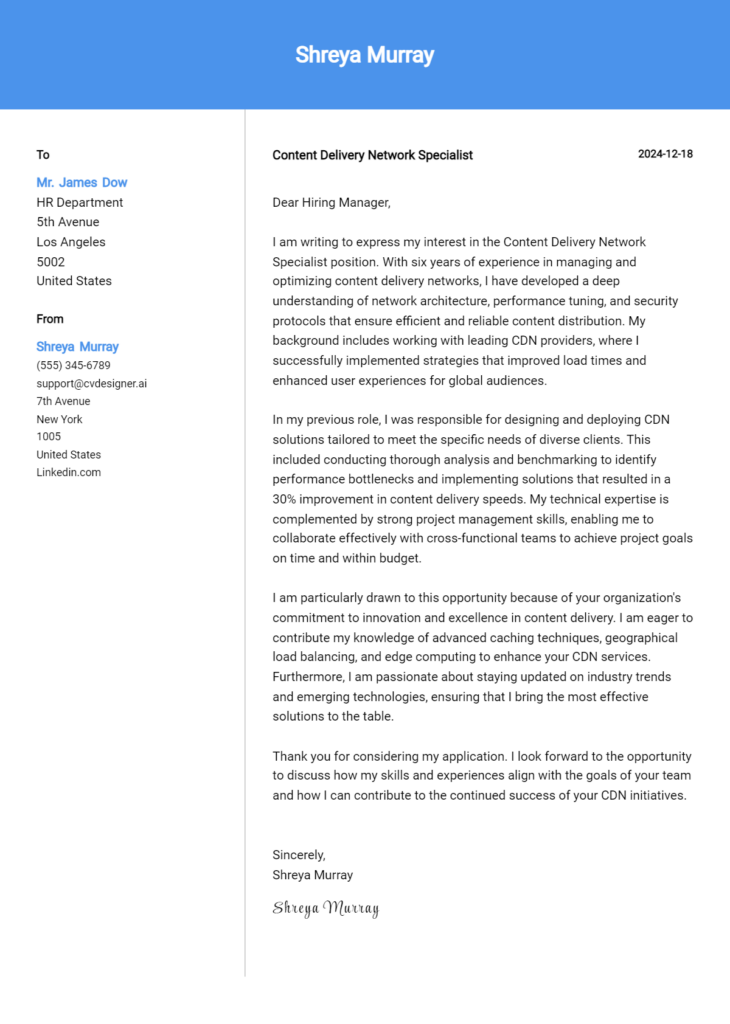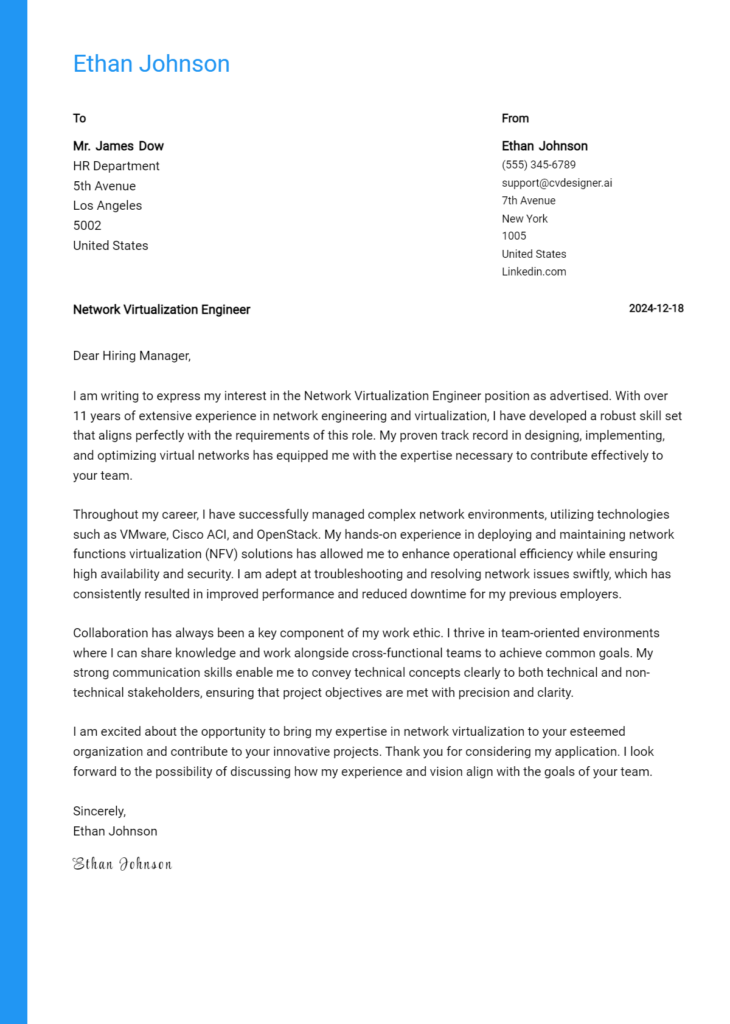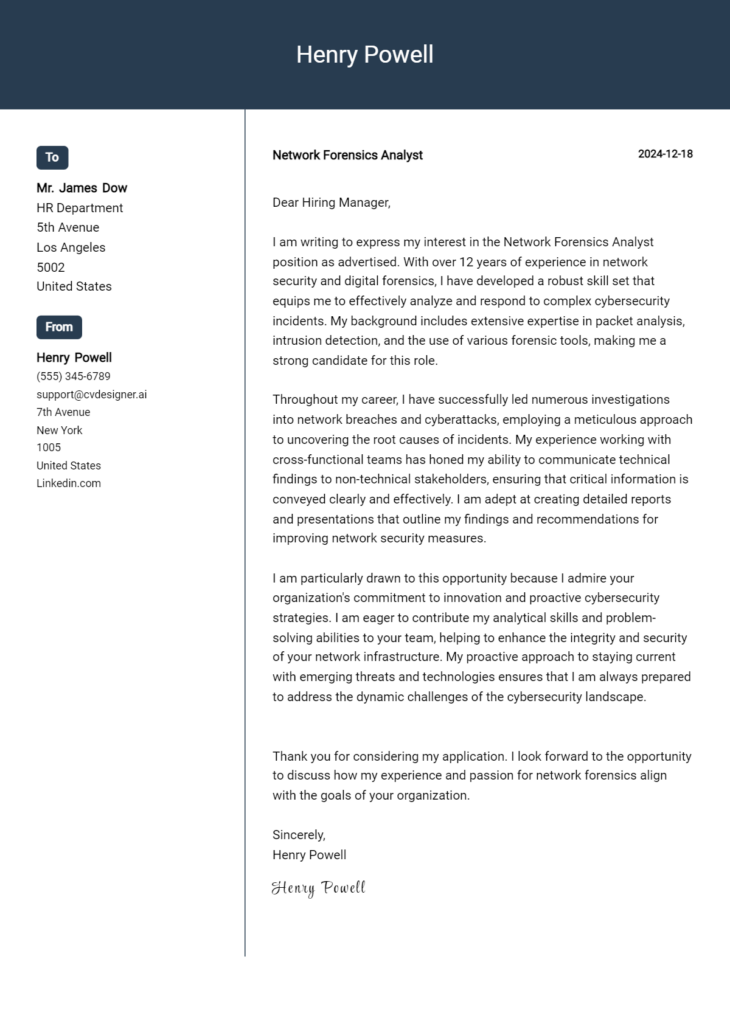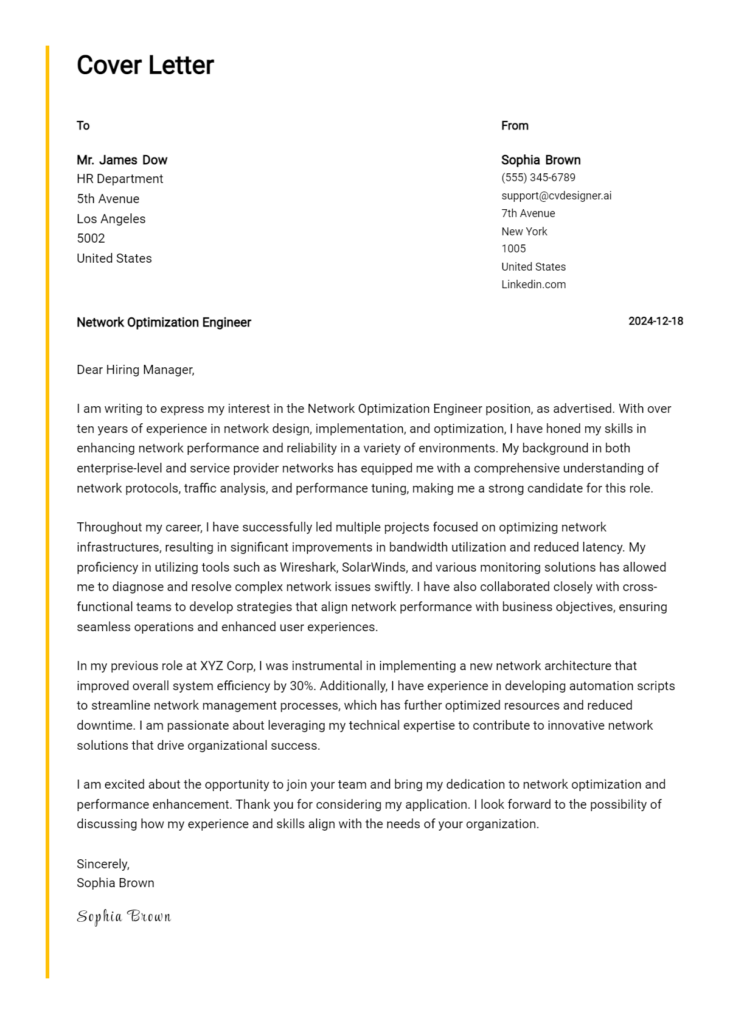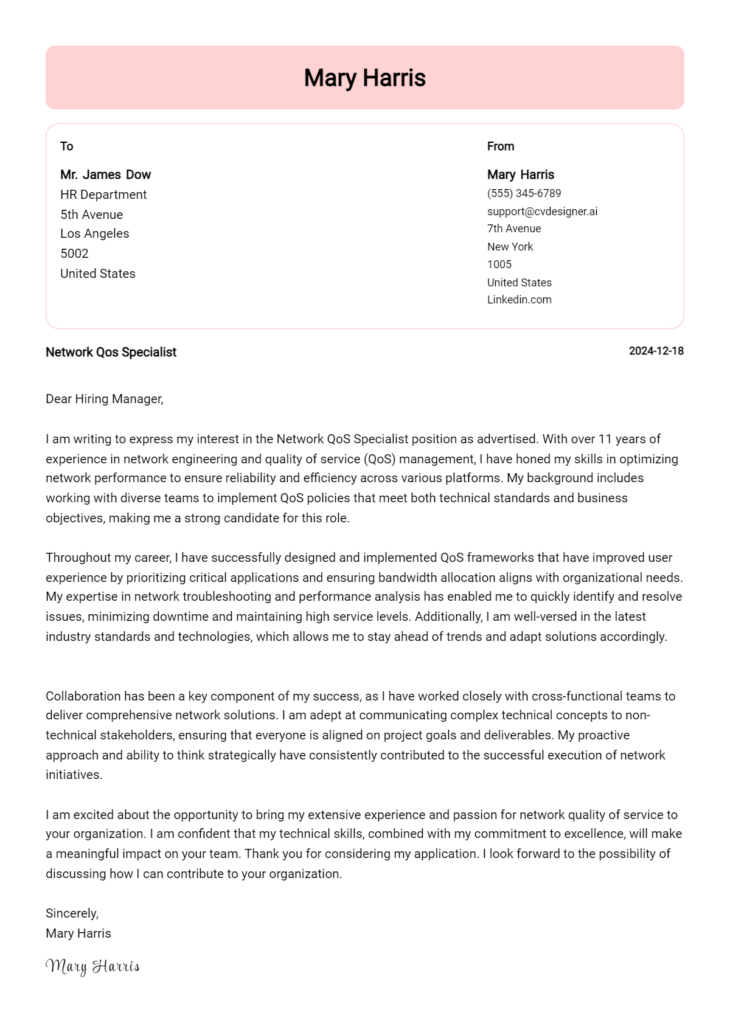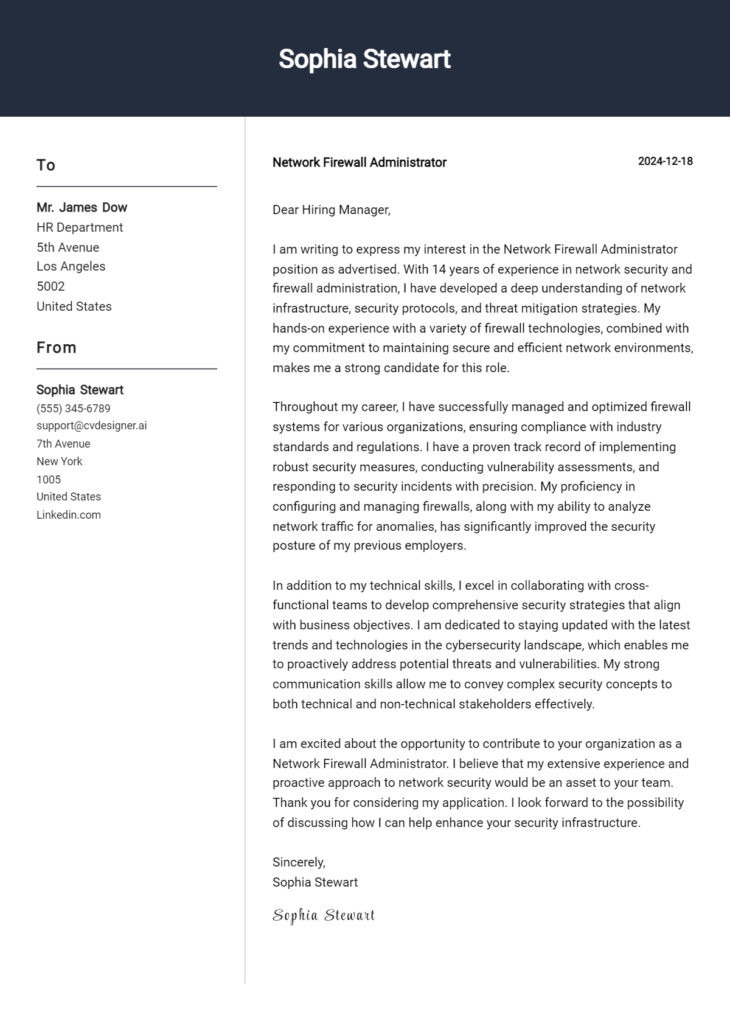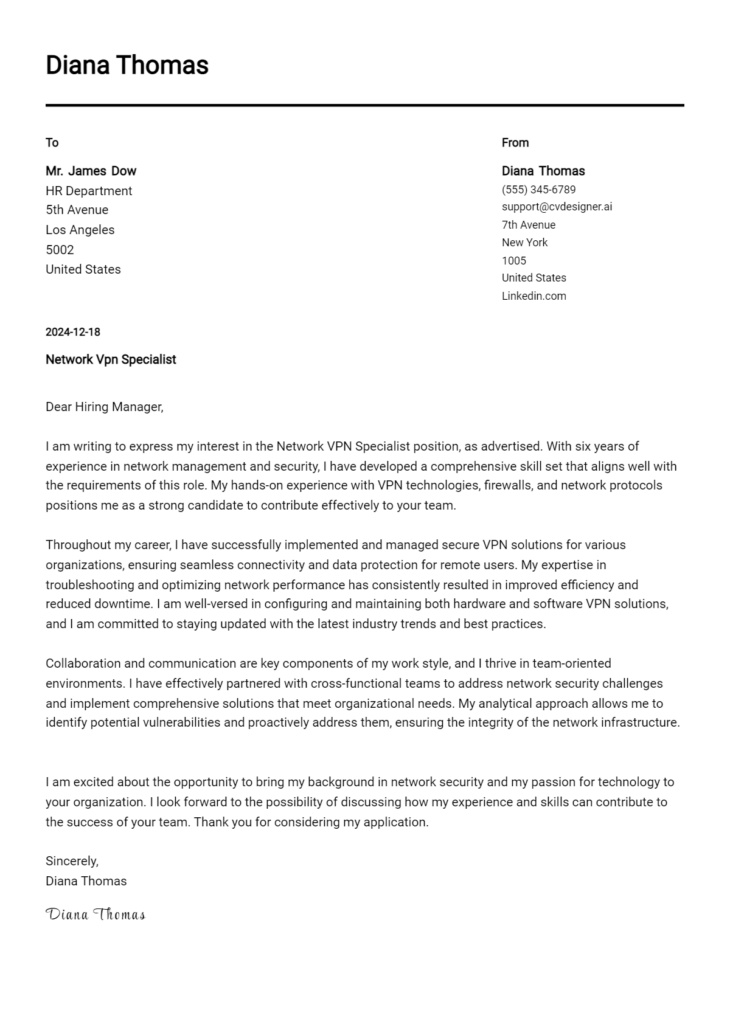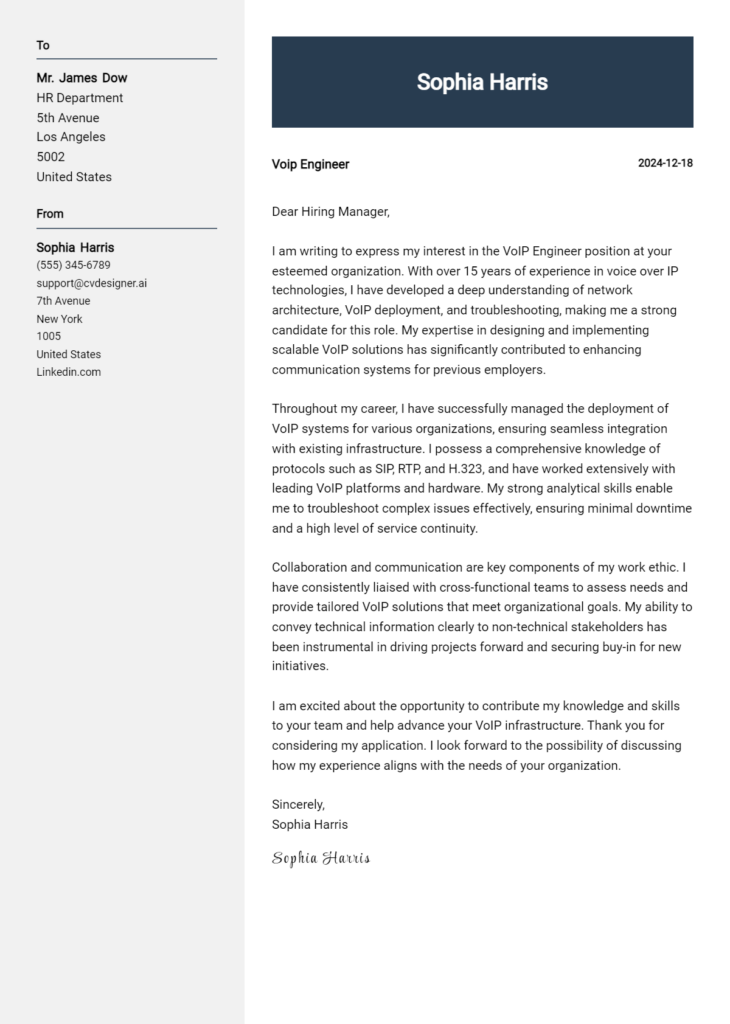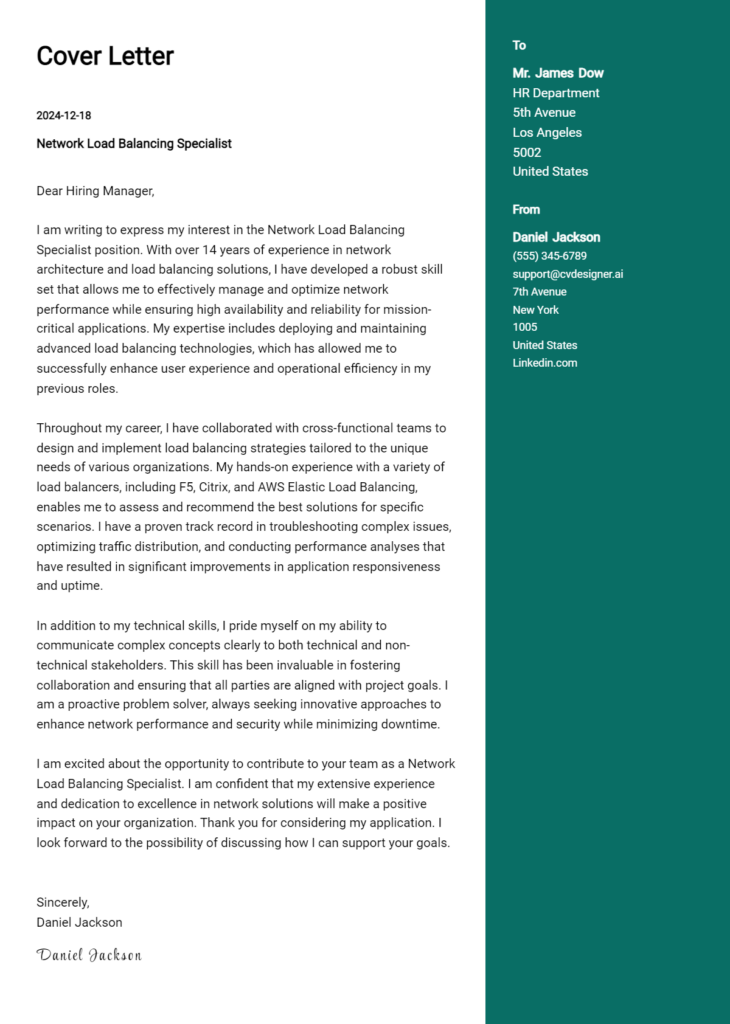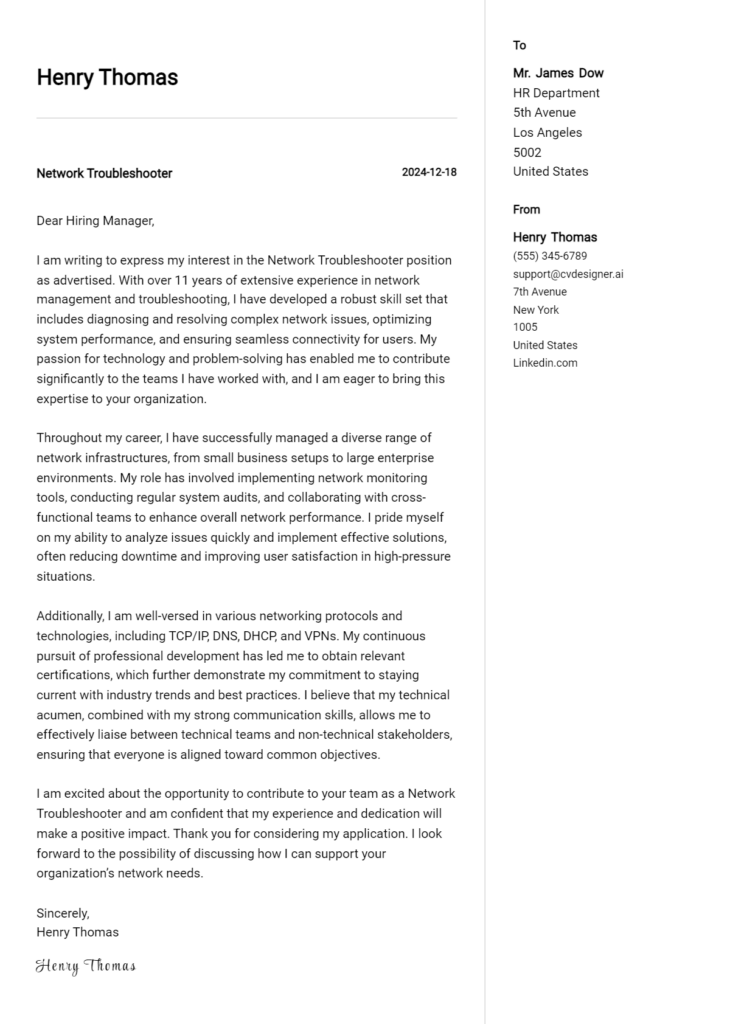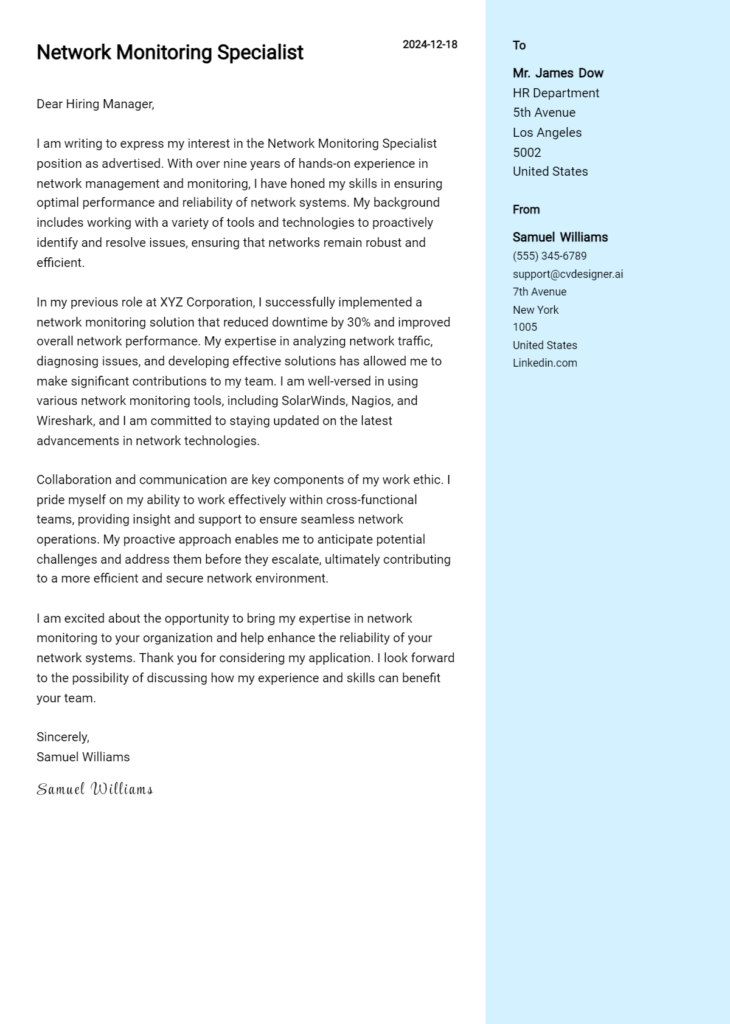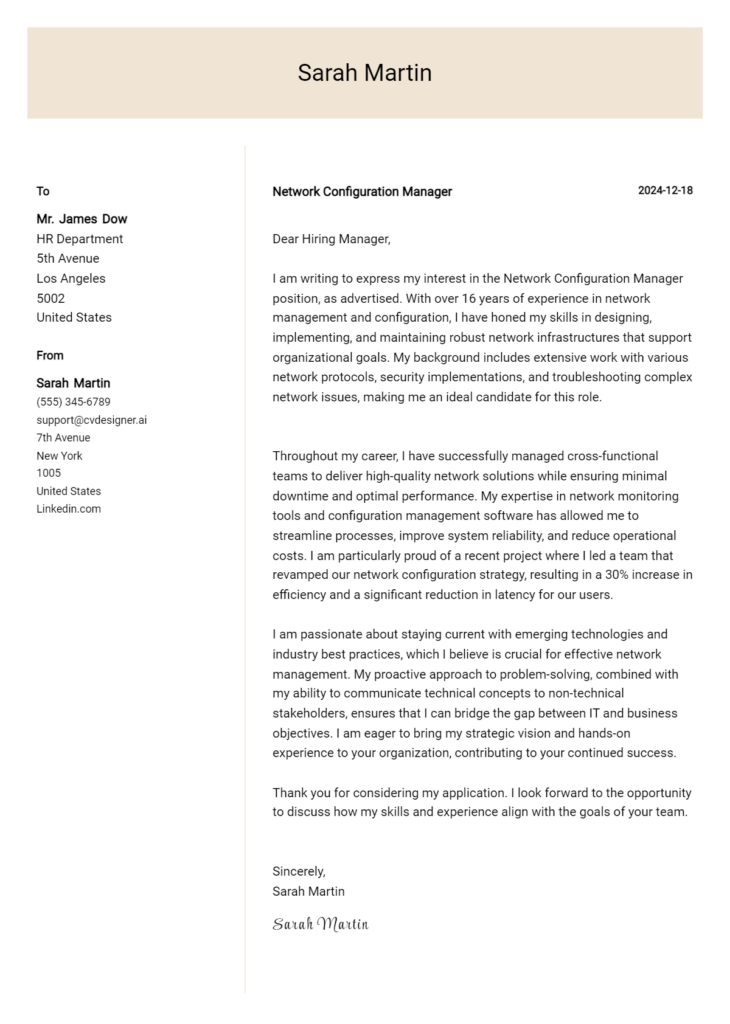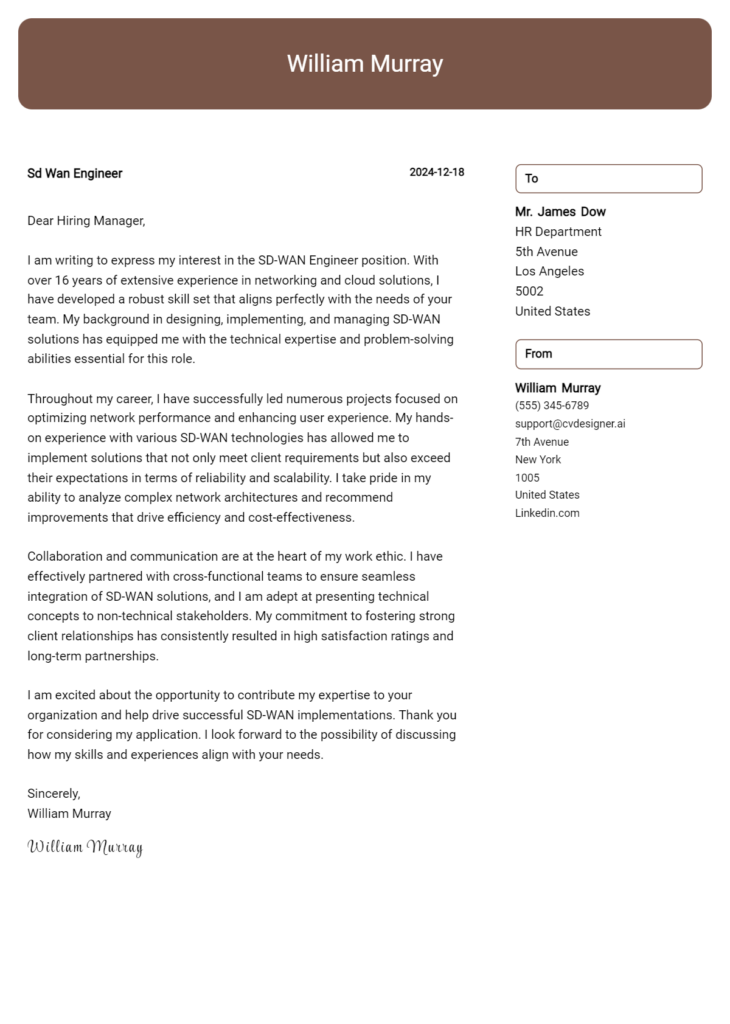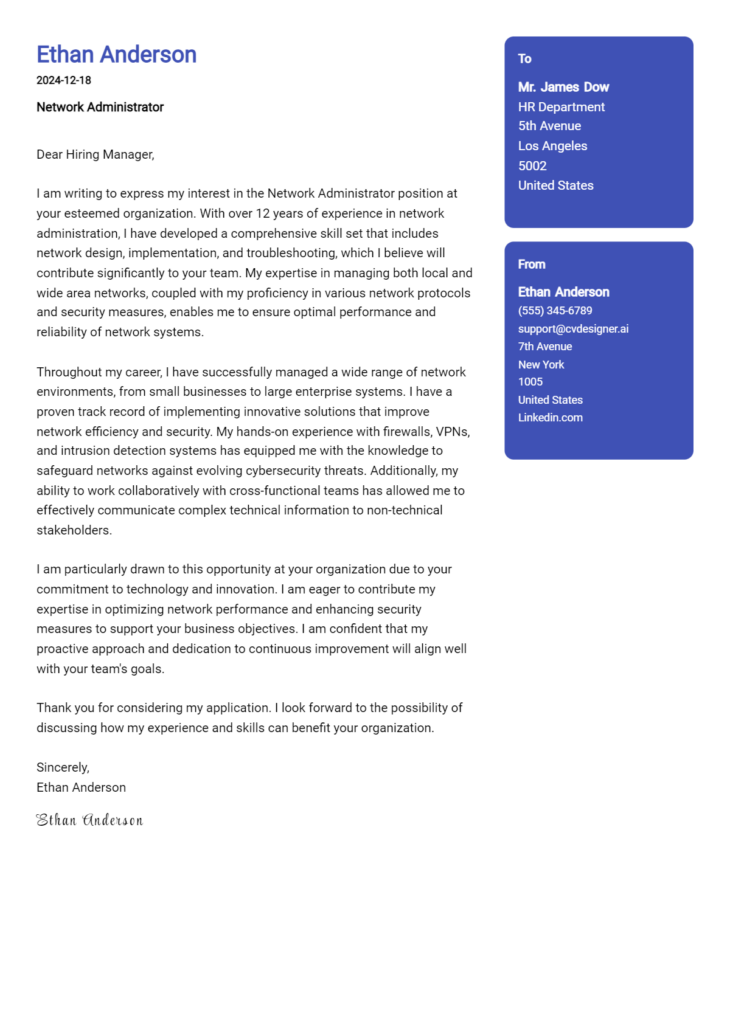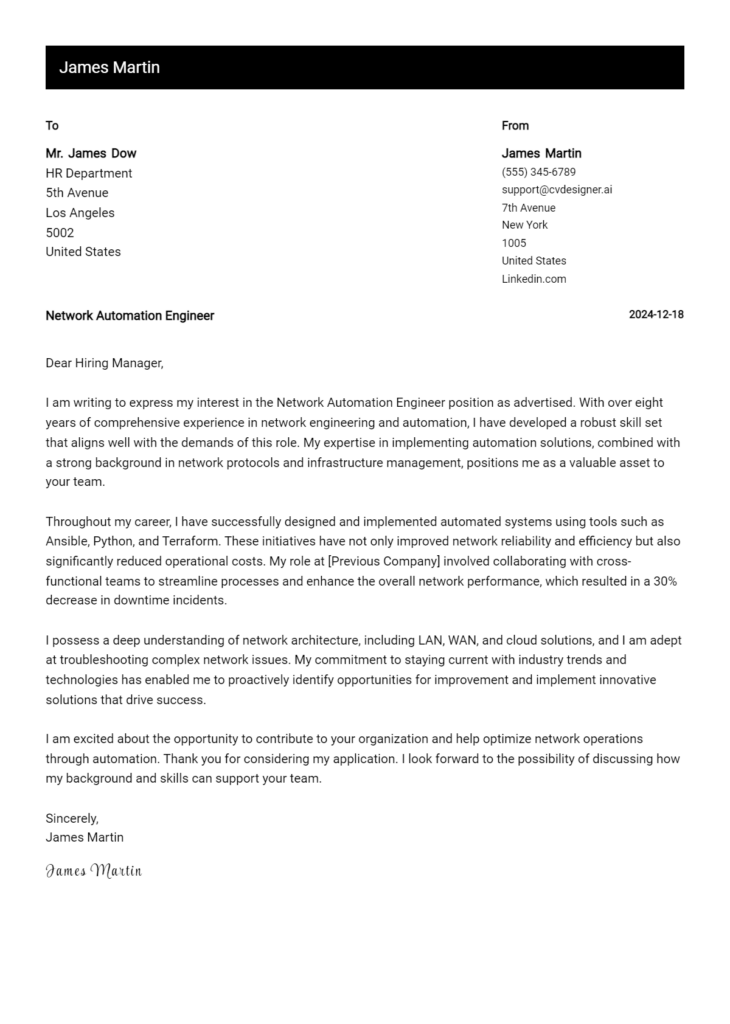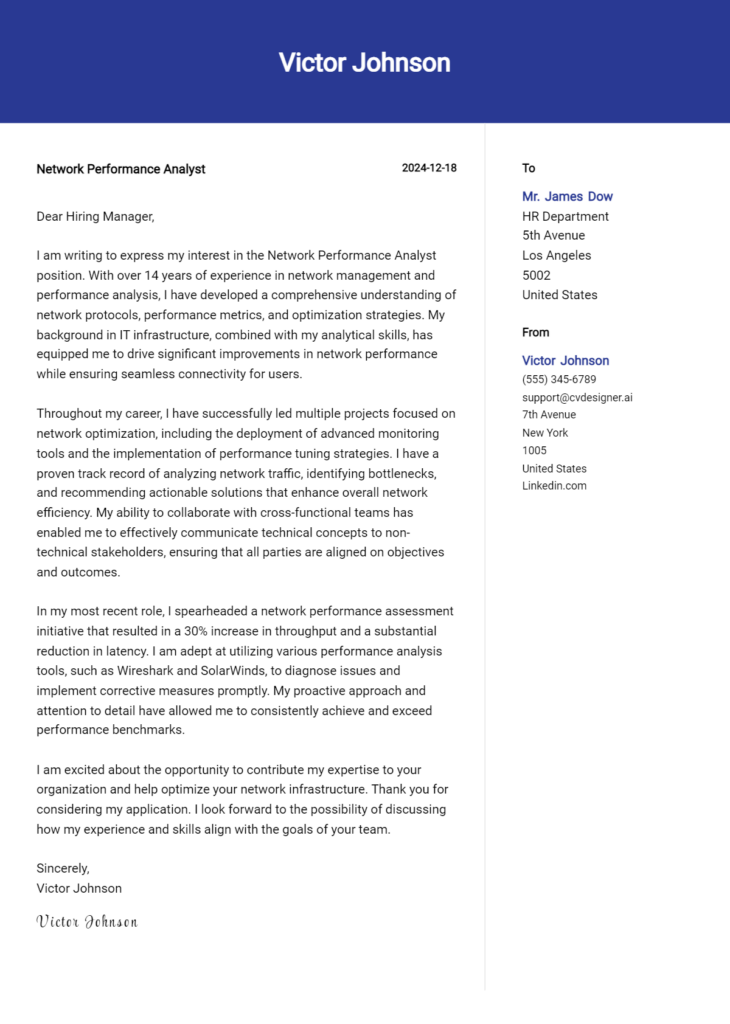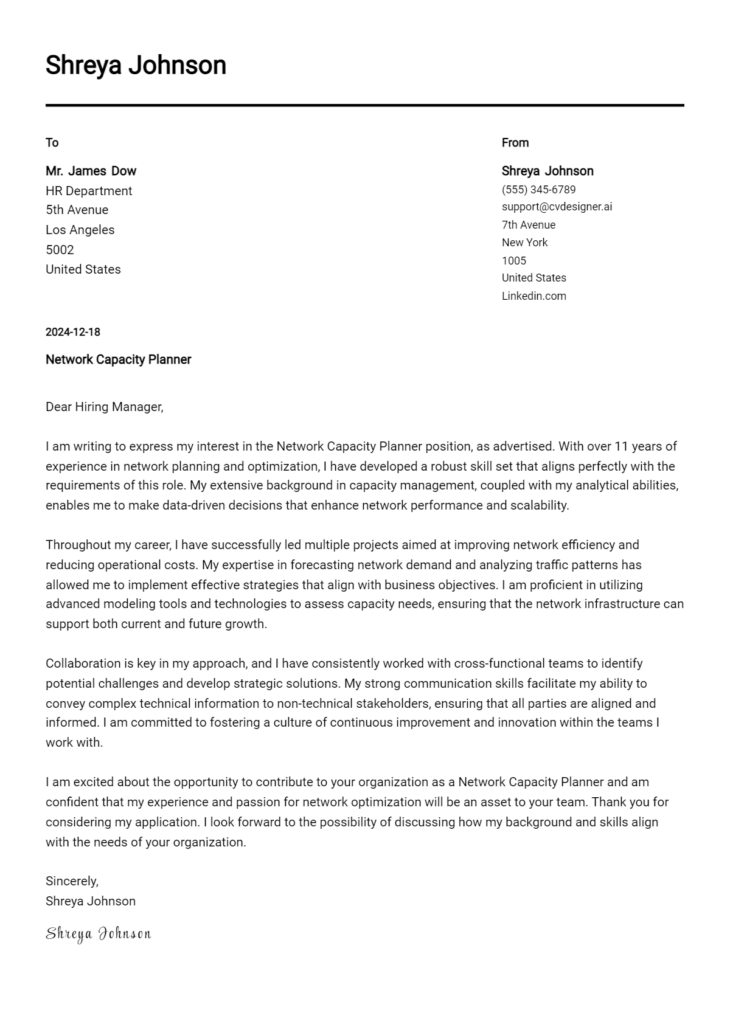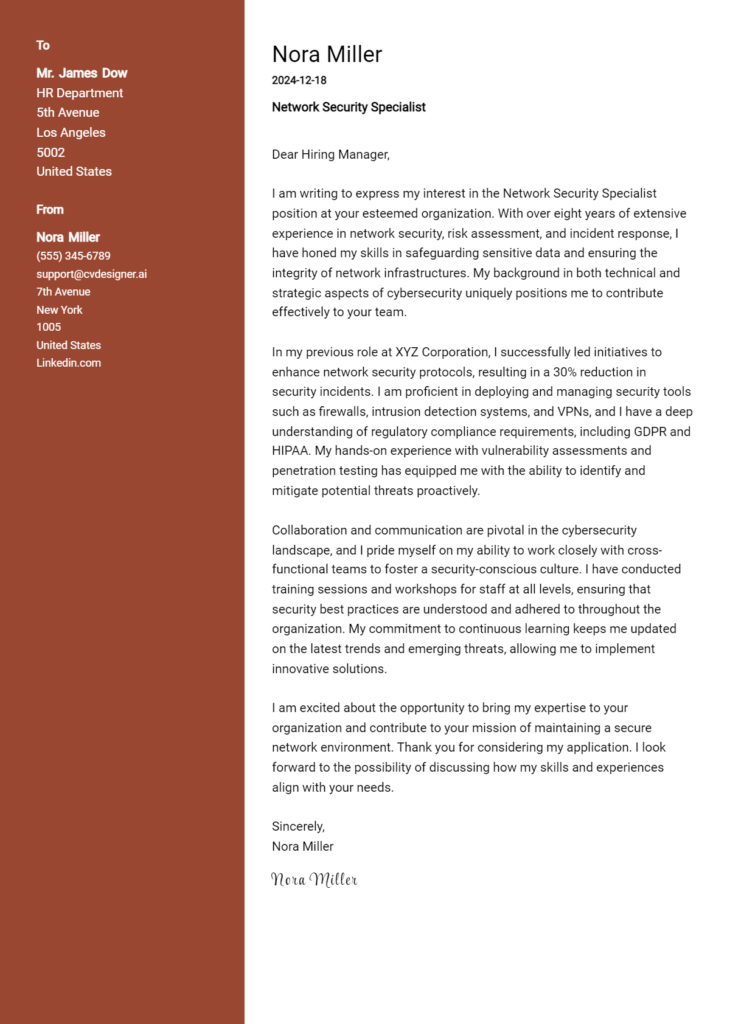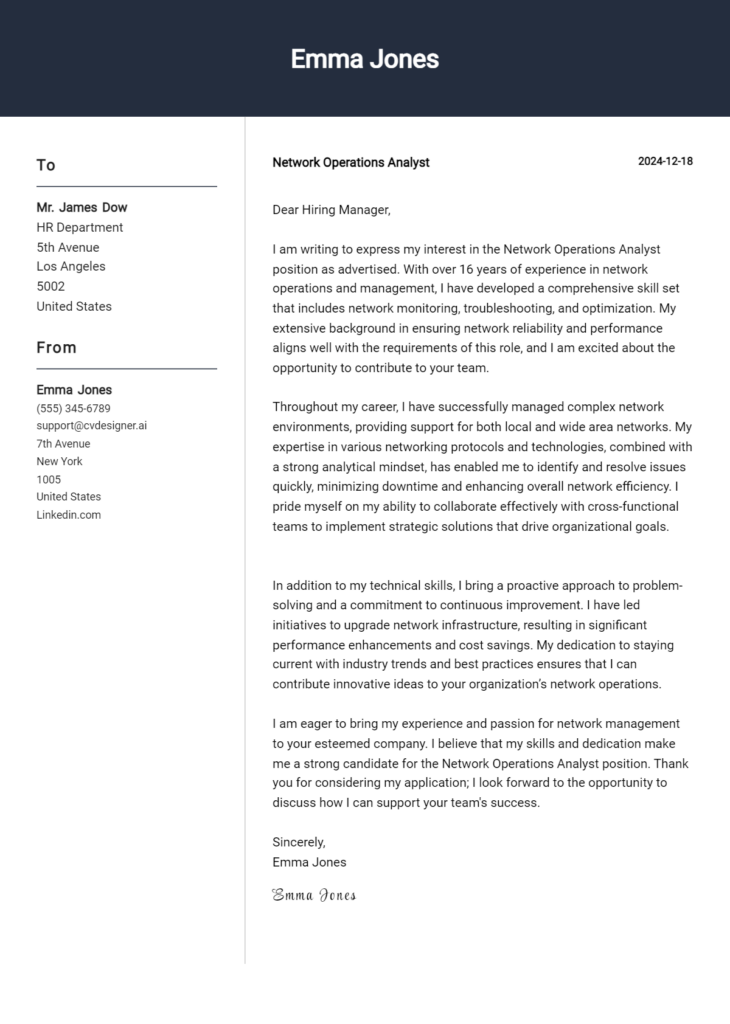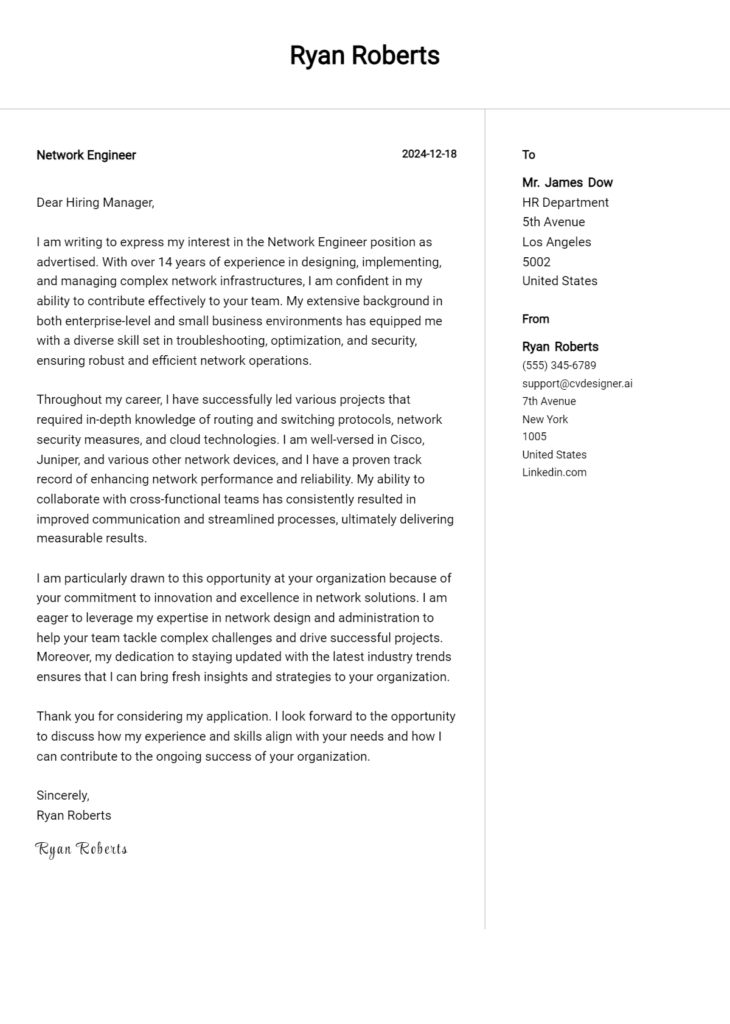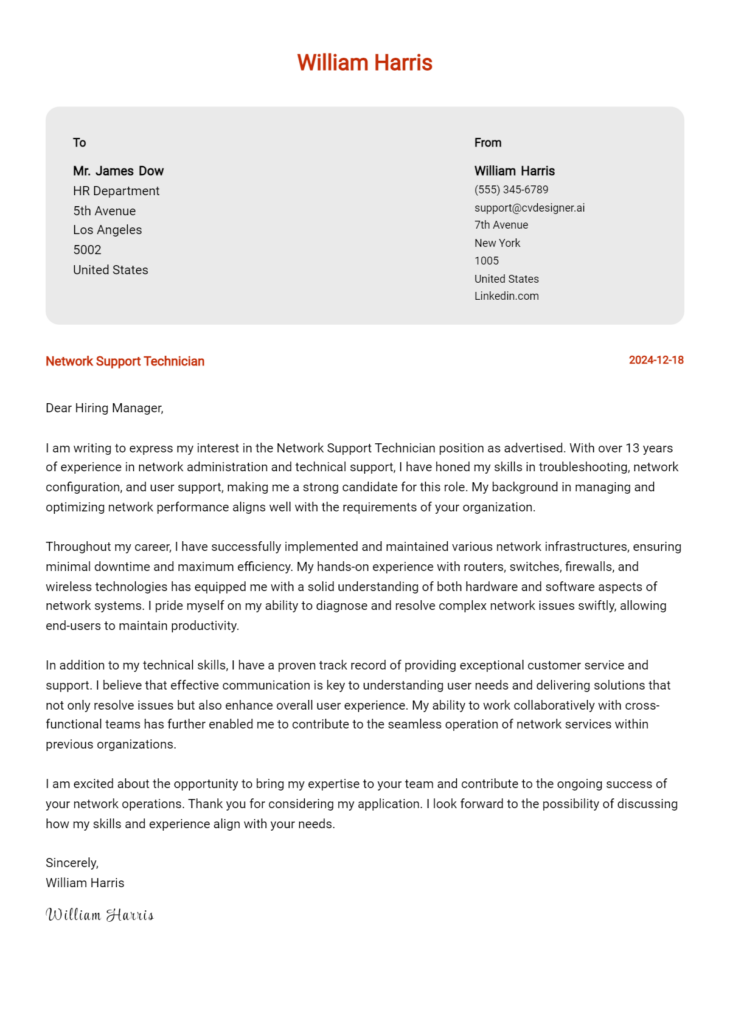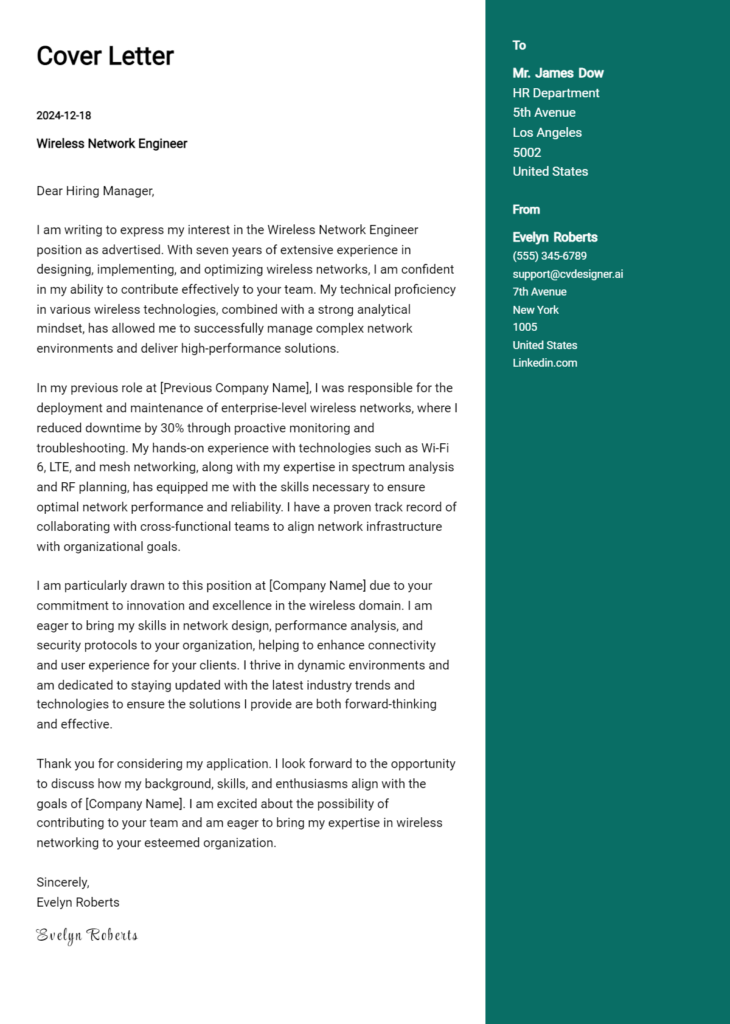Network Resilience Specialist Cover Letter Examples
Explore additional Network Resilience Specialist cover letter samples and guides and see what works for your level of experience or role.
How to Format a Network Resilience Specialist Cover Letter?
Crafting an impactful cover letter is essential for a Network Resilience Specialist, as it serves as a first impression to potential employers. The way you format and present your cover letter not only showcases your communication skills but also reflects your understanding of the critical nature of network reliability and resilience in today’s digital landscape. A well-structured cover letter helps to convey your qualifications effectively, demonstrating your analytical abilities and attention to detail—two vital traits for someone in this role.
In this guide, we will outline the key components of a professional cover letter, providing specific insights and examples tailored to the network resilience field.
We’ll focus on the essential elements, including:
- Cover Letter Header
- Cover Letter Greeting
- Cover Letter Introduction
- Cover Letter Body
- Cover Letter Closing
Each section plays a crucial role in emphasizing your qualifications and professionalism. Let’s delve into each part and explore how to make your Network Resilience Specialist cover letter stand out.
Importance of the Cover Letter Header for a Network Resilience Specialist
The cover letter header is a crucial component that sets the tone for your application as a Network Resilience Specialist. It provides essential information in a clear and professional format, allowing the recipient to easily identify who you are and how to contact you. A well-structured header includes your contact information, the date, and the recipient's details, ensuring that your application is both organized and accessible. Clarity and professionalism in the header not only reflect your attention to detail but also demonstrate your suitability for a role that demands precision and reliability, characteristics vital for maintaining network resilience.
Strong Example
John Doe 123 Network Lane Tech City, TX 75001 john.doe@email.com (123) 456-7890 October 5, 2023 Ms. Jane Smith Hiring Manager Resilience Networks Inc. 456 Security Blvd Tech City, TX 75002
Weak Example
Hi there, I want to apply for the Network Resilience Specialist position. My email is john.doe@email.com.
The Importance of a Strong Cover Letter Greeting
The greeting of a cover letter is crucial as it sets the tone for the entire correspondence. A well-crafted greeting not only demonstrates professionalism but also shows a level of personalization that can make a positive impression on the hiring manager. Addressing the hiring manager directly can help establish a connection and indicate that you have taken the time to research the company and its personnel. Avoiding generic greetings such as "To whom it may concern" is essential, as they often come across as impersonal and can diminish the impact of your application. Instead, aim to find the name of the hiring manager through the company website, LinkedIn, or by calling the company directly if necessary.
Strong Greeting Example
Dear Ms. Johnson,
Weak Greeting Example
To whom it may concern,
The Importance of a Well-Crafted Cover Letter Introduction for a Network Resilience Specialist
A well-crafted cover letter introduction is crucial for a Network Resilience Specialist, as it sets the tone for the rest of the application and serves as the first impression to the hiring manager. This opening paragraph should not only capture the reader's attention but also convey the candidate's enthusiasm for the role while succinctly highlighting key skills or achievements relevant to network resilience and security. A strong introduction can differentiate a candidate in a competitive job market, making it essential to strike the right balance between professionalism and personal connection.
Strong Example
Dear [Hiring Manager's Name], As a dedicated Network Resilience Specialist with over five years of experience in designing and implementing robust network infrastructures, I was thrilled to discover the opportunity at [Company Name]. My proven track record in enhancing system availability by 40% and my certifications in both CCNP and AWS Solutions Architect position me well to contribute to your team's mission of ensuring seamless connectivity and minimal downtime. I am eager to bring my expertise in risk assessment and disaster recovery planning to [Company Name], where I can help fortify your network against evolving threats.
Weak Example
To Whom It May Concern, I am applying for the Network Resilience Specialist position because I need a job. I have worked in IT for a few years and know a bit about networks. I think I could probably do well in this role if you give me a chance.
Purpose of the Cover Letter Body for a Network Resilience Specialist
The body of the cover letter for a Network Resilience Specialist serves as a critical platform to present the candidate's unique qualifications, experiences, and contributions to potential employers. This section should effectively illustrate how the candidate's expertise in network resilience—through specific projects, achievements, and problem-solving capabilities—can add significant value to the organization. By detailing relevant accomplishments, such as successful implementations of redundancy protocols or the development of disaster recovery plans, candidates can clearly convey their ability to enhance network reliability and performance.
Strong Example
Dear [Hiring Manager's Name], I am excited to apply for the Network Resilience Specialist position at [Company Name]. In my previous role at [Previous Company], I led a project that revamped our network redundancy strategy, resulting in a 40% decrease in downtime during peak hours. By implementing a new load balancing system and conducting regular resilience testing, we not only improved user experience but also enhanced our overall network security posture. Additionally, I developed a comprehensive disaster recovery plan that was successfully executed during a simulated outage, demonstrating our team's preparedness and commitment to operational continuity. I am eager to bring my expertise in network resilience and my proven track record of optimizing network performance to [Company Name]. Sincerely, [Your Name]
Weak Example
Dear [Hiring Manager's Name], I am writing to express my interest in the Network Resilience Specialist position. I have worked in IT for several years and have some experience with networks. I think I would be a good fit for the job because I know a bit about network issues. I once helped fix a network problem at work, which was good. I hope to bring my skills to [Company Name] and help with network problems. Best, [Your Name]
Importance of the Cover Letter Closing for a Network Resilience Specialist
The closing paragraph of your cover letter is crucial as it provides a final opportunity to summarize your qualifications, reiterate your interest in the Network Resilience Specialist role, and encourage the employer to take the next steps, such as reviewing your resume or scheduling an interview. A strong closing leaves a lasting impression and demonstrates your enthusiasm for the position, while a weak closing may undermine the positive impact of the rest of your letter.
Strong Example
In conclusion, my extensive experience in network architecture and incident response, coupled with my passion for enhancing organizational resilience, positions me as a strong candidate for the Network Resilience Specialist role. I am truly excited about the opportunity to contribute to your team and help safeguard your network infrastructure. I look forward to discussing my qualifications in more detail and am eager to explore how I can support your organization's goals. Thank you for considering my application, and I hope to hear from you soon to schedule an interview.
Weak Example
To wrap up, I think I’d be good for the Network Resilience Specialist job. I have some experience in networks, and I hope you'll look at my resume. Thanks for your time, I guess.
These tips will guide candidates in creating an impactful cover letter for a Network Resilience Specialist position. As this role demands a blend of technical expertise and interpersonal skills, it's crucial to highlight your problem-solving abilities, knowledge of the Software Development Life Cycle (SDLC), and your capacity for teamwork. Additionally, demonstrating a commitment to continuous learning will set you apart from other candidates. Below are five essential tips to help you craft a compelling cover letter.
Tips for Writing an Effective Cover Letter for a Network Resilience Specialist
Showcase Your Technical Skills
Clearly outline your relevant technical skills, such as expertise in network architecture, security protocols, and disaster recovery solutions. Use specific examples to illustrate how you’ve applied these skills in past roles. This not only demonstrates your qualifications but also shows your readiness to tackle the technical challenges of the position.Highlight Problem-Solving Abilities
Network resilience often requires quick thinking and effective problem-solving skills. Share a brief anecdote where you successfully diagnosed and resolved a network issue under pressure. This will help the hiring manager understand your analytical capabilities and your approach to troubleshooting.Demonstrate Knowledge of the SDLC
Familiarity with the Software Development Life Cycle is essential for a Network Resilience Specialist. In your cover letter, mention your experience with SDLC phases, particularly in how you’ve contributed to the planning, implementation, and maintenance of network systems. This shows your holistic understanding of how network resilience fits within broader IT operations.Emphasize Teamwork and Collaboration
Network resilience is often a team effort, so it’s important to convey your ability to work effectively with others. Discuss your experience collaborating with cross-functional teams, whether in project management or during crisis response situations. Highlighting your communication skills will reinforce your ability to thrive in a collaborative environment.Express Passion for Continuous Learning
The field of network resilience is constantly evolving, so showcasing your commitment to ongoing education is vital. Mention any relevant certifications, workshops, or courses you’ve completed, and express your enthusiasm for staying updated with the latest technologies and best practices. This demonstrates your proactive nature and dedication to your profession.
By following these tips, you can create a strong cover letter that effectively highlights your qualifications for the Network Resilience Specialist role. For additional guidance, consider utilizing cover letter templates or a cover letter builder to streamline your writing process.
Common Mistakes to Avoid in a Network Resilience Specialist Cover Letter
Crafting a compelling cover letter is essential for standing out in the competitive field of network resilience. Avoiding common mistakes can significantly enhance your chances of making a positive impression on potential employers. Here are some frequent pitfalls to be aware of, along with tips for steering clear of them:
Generic Content: Many candidates use a one-size-fits-all approach. Tailor your letter specifically to the Network Resilience Specialist role by highlighting relevant skills and experiences.
Neglecting Formatting: A cluttered or unprofessional layout can detract from your message. Adhere to a clean cover letter format to ensure readability and professionalism.
Overly Lengthy Letters: Brevity is key. Aim for a concise letter that focuses on your most relevant qualifications and avoids unnecessary repetition.
Lack of Specific Examples: Failing to provide concrete examples of your achievements can weaken your application. Use specific instances from your experience to demonstrate your expertise in network resilience.
Ignoring the Job Description: Many applicants overlook the details in the job listing. Highlight how your skills align with the requirements outlined in the description to show you're a perfect fit.
Typos and Grammatical Errors: Errors can undermine your credibility. Always proofread your letter carefully or use tools to check for mistakes before submitting.
Weak Closing Statement: A vague or unenthusiastic closing can leave a poor impression. End with a strong statement that reinforces your interest and invites further discussion.
By avoiding these mistakes and following best practices, you can create a standout cover letter that captures the attention of hiring managers. For further inspiration, explore cover letter examples that can guide you in crafting your own.
Cover Letter FAQs for Network Resilience Specialist
What should I include in my cover letter for a Network Resilience Specialist position?
In your cover letter, focus on showcasing your expertise in network architecture, redundancy strategies, and risk assessment. Start with a brief introduction about your background and interest in the position. Highlight specific achievements that demonstrate your ability to enhance network resilience, such as successful implementations of failover systems or disaster recovery plans. Additionally, include keywords from the job description, emphasizing your technical skills in relevant tools and technologies. Finally, convey your understanding of the company’s objectives and how your background aligns with their needs, demonstrating your commitment to improving their network infrastructure.
How can I tailor my cover letter to the specific job description?
To tailor your cover letter effectively, analyze the job description for key responsibilities and required skills. Make a list of the primary qualifications they seek and match them with your experience. For example, if the job emphasizes experience with cloud-based solutions, include specific projects where you implemented such technologies. Use the employer's language and terminology to demonstrate alignment with their values and goals. Additionally, reference any knowledge you have about their current challenges or projects, and explain how your expertise can directly address these needs. This personalized approach shows that you have done your research and are genuinely interested in the role.
How long should my cover letter be for this position?
Your cover letter should ideally be one page long, containing three to four paragraphs. Keep it concise and focused—each paragraph should serve a specific purpose. The opening paragraph should introduce yourself and express your interest in the Network Resilience Specialist position. The following paragraphs should detail your relevant experience, skills, and achievements, illustrating how they align with the job requirements. Conclude with a strong closing statement that reiterates your enthusiasm for the role and invites further discussion. By maintaining brevity and clarity, you ensure that hiring managers can quickly grasp your qualifications and interest.
Should I include technical jargon in my cover letter?
While it’s important to demonstrate your technical expertise, be cautious with the use of jargon. Tailor the level of technical language to your audience. If the hiring manager is a technical expert, including relevant terminology can showcase your familiarity with the field. However, if your cover letter might be read by HR personnel or non-technical managers, aim for a balance. Explain complex terms clearly and provide context for your technical achievements. This approach ensures that your qualifications are understood by all readers, while still highlighting your expertise in network resilience and related technologies.
Build your Cover Letter in minutes
Use an AI-powered cover letter builder and have your letter done in 5 minutes. Just select your template and our software will guide you through the process.

